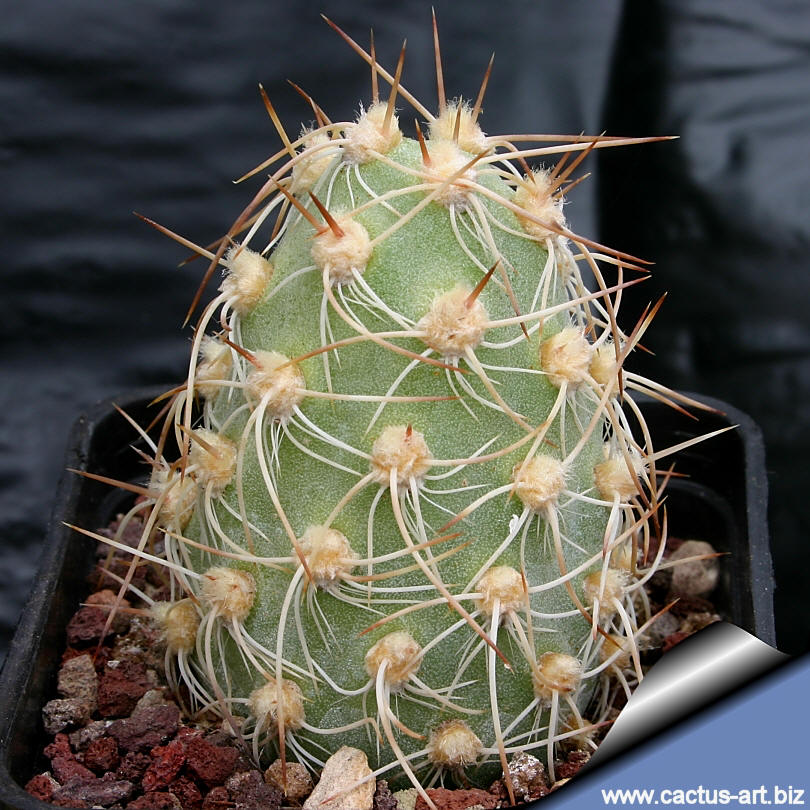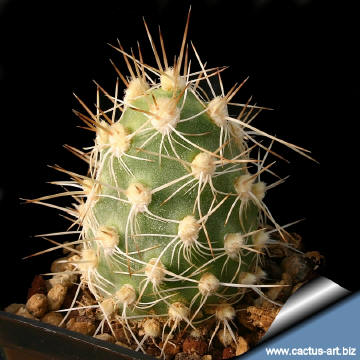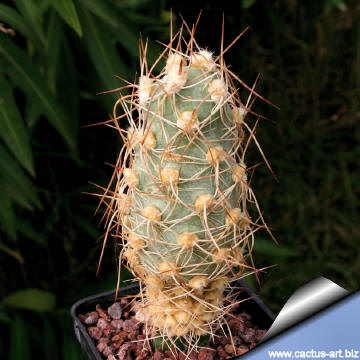|
|
|

Cumulopuntia sphaerica ISI
1525 ex. Mollando Rd, Peru 2800m
|
|
Description: In habitat the plants stay rather small and grow mainly
prostrate or semi-erect and are moderately branched, fragile. It is
quite variable in segment shape and size, the segments are usually large
and spherical (hence the name) but some populations have somewhat
elongate segments or are miniature-structured.
Stem: Each segment 2.5-5(6) cm; globose, tuberceles vestigial or
absent;
Areoles: Large, 3-6 mm in diameter or more, prominent, close-set,
sometimes almost contiguous, extending to base of segment 25-80 or more,
the upper approx. 2/3 to nearly all the total spiniferous.
Leaves: The leaves are minute and ephemeral.
Spines: 2-15, porrect, stout, usually straight, sometimes bent,
unequal, 1-4 cm, reddish or darkish, pallid in age, occasionally
reduced to few inconspicuous bristles about 0.5 cm;
Flower: 4 cm; pericarpels broad, squat, with areoles above
bearing small spines near or on rim; tephals orange;
Fruits: with shallow umbilicus, globose, ±spiny;
Seed: rather small, 3.5(-4) mm, subglobose, smooth, with
ribbon-like girdle nearly flush with the surface.
|
|
 |
 |
|
Advertising
|
|
|
|
|
|
|
Family:
Cactaceae (Cactus
Family)
Scientific name: Cumulopuntia sphaerica (C.F.Först.)
E.F.Anderson1999
Origin: South America, widespread from
central Chile (Antofagasta, Atacama, Coquimbo, Libertador General
Bernardo O 'Higgins, Santiago, Tar apaca, Valparaiso) to Peru, (Ayacucho,
Arequipa, Moquegua, Tacna)
Habitat: It grow in general at not very
high altitudes but higher in more northern (tropical) part of the range
where it can be found above the 3000m. This species requires higher
temperatures in summer and winter as well, as it grows in the nature
together with Melocactus peruvianus, too.
NOTE: Cumulopuntia is a very controversial genus genus of
cacti closely related to Maihueniopsis.
Synonyms:
- Tephrocactus sphaericus (C. F. Forst.)
Backeb.
in Backeb. & F.M.Knuth - Kaktus-ABC 111. 1935
- Tephrocactus dimorphus var.
pseudorauppianus
- Tephrocactus muellerianus
- Tephrocactus mirus
- Opuntia muelleriana
- Tephrocactus multiareolatus
- Cumulopuntia multiareolata
- Tephrocactus pseudorauppianus
- Opuntia dimorpha var. pseudorauppiana
- Opuntia pseudorauppiana
- Cumulopuntia rauppiana
- Opuntia rauppiana
- Tephrocactus sphaericus var. rauppianus
- Tephrocactus rauppianus
- Opuntia leucophaea
- Cumulopuntia tubercularis
- Opuntia sphaerica var. rauppiana
- Opuntia berteri
- Tephrocactus kuehnrichianus
- Opuntia sphaerica
- Tephrocactus sphaericus
- Cumulopuntia berteri
- Cactus berteri
- Opuntia mira
- Tephrocactus berteri
- Tephrocactus campestris
- Opuntia campestris
- Tephrocactus dimorphus
- Opuntia dimorpha
- Cumulopuntia kuehnrichiana
- Opuntia kuehnrichiana
- Echinocactus berter
|
|
|
|
Cultivation: Cumulopuntia cannot endure any standing heat and
need an absolutely airy and sunny place this brings very healthy plants
with a good spination and flowers. Use a very draining compost-mix with
a high mineral content, they needed deeper pots to accommodate the big
tap root. Water and feed in the vegetation period from April until to
mid of September, keep dry and cool in winter, they have to be
stimulated to bloom by dryness and you may give them water first when
the plats start to produce the new buds. Pot bound, starved plants will
rapidly look tatty and won’t flower well.
Propagation: Cuttings (let dehydrate the cuttings for a few weeks
and the roots will coming quick)

 |
|